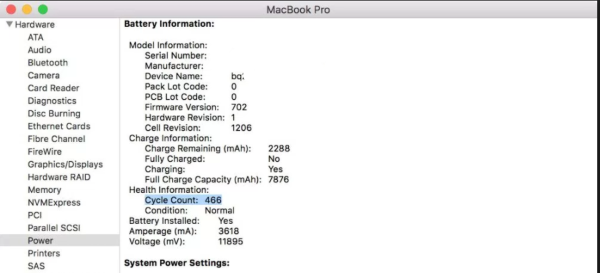
It can be nerve-wracking to open your MacBook Pro to a ‘Service Battery’ alert on your MacBook. In this blog post we will explain how your MacBook battery works, some suggestions on how to resolve the ‘Service Battery’ alert and when you ultimately need a battery replacement.
What is a Lithium-Ion Battery?
Lithium-ion batteries charge quickly, are long-lasting and provide the best technology to power your computer.
All chemical batteries work on the same basic principle: a positive electrode is separated from a negative electrode by an electrolyte. When the battery is connected to an electrical current that draws power, electrons flow from the anode to the cathode, creating a current.
With a rechargeable battery, such as the one in your MacBook, this flow can be reversed, electrons flow from the positive to the negative electrode, recharging the battery and adding power to it.
We discuss MacBook battery life, battery cycles, and how to keep your MacBook’s battery healthy in greater depth in this blog post.
What Does ‘Service Battery’ on my Mac Mean?
Your MacBook monitors the health of its battery. You can view your battery health at any time. If you click on the battery icon on the status bar at the top of your screen, a popup displays the status, amount of power remaining and a list of apps using significant amounts of energy.
There are four battery status messages that you can see on your MacBook:
- Normal: Just what it sounds like - your battery is operating normally.
- Replace Soon: The battery is holding less of a charge than it did when it was new. But it’s still working.
- Replace Now: The battery still works, but has degraded significantly. It’s time to think about a replacement.
- Service Battery: There is something wrong with your battery and it needs to be replaced as soon as possible.
The first thing you can do to investigate further when you get a ‘Service Battery’ notification is to check the ‘System Report’. To view this report click the Apple icon while holding the Option key.
Click on System Information and select Power on the left side to review your battery health.
Modern Macs usually get at least 1,000 cycles before issues arise. However, if you have an older MacBook, you may only have 500 cycles before the battery is worn out.
If you get the dreaded ‘Service Battery’ warning and your cycles are above 1,000 - then your battery is likely close to worn out. But if your cycles are relatively low, then there may be other issues at play.

Here are a few things you can try before replacing your battery.
Reset Your System Management Controller (SMC)
This process is straightforward but can reset customizations to your power plan or hardware settings.
Here’s how to do it.
- Shut down your MacBook Pro.
- Press Shift+Ctrl+Option+Power at the same time and hold.
- Release all keys at the same time.
- Turn on your laptop.
If an issue in the SMC was causing the ‘Service Battery’ warning this should fix it. Be aware that SMC controls computer fans, backlights, indicator lights and some aspects of the display, ports and battery - so resetting it can revert your MacBook back to its default settings for these things.
Recalibrate Your MacBook Battery
Another step you can take is to recalibrate your battery. This basically means completely discharging and then recharging your battery. This process takes about a day.
Here’s how to recalibrate your MacBook’s battery:
- Fully charge your MacBook to 100%
- Keep the laptop running while connected to a power supply for a couple of hours.
- Unplug the MacBook from the power supply and let the battery drain completely.
- Leave your MacBook overnight without the power cord connected.
- The next morning, plug your MacBook in, and charge it back to 100%.
When It’s Time for a Battery Replacement
If neither of these steps work, then it’s time to take your Mac into an Authorized Apple Repair Service Center.
You can make an appointment for a battery replacement at any of our Digitiqe locations.





